A Rotating Tidal Current Controller and Energy Router Siting and Capacitation Method Considering Spatio-Temporal Distribution
Abstract
1. Introduction
- (1)
- Model Construction: This work presents the first construction of a grid planning model that includes the RPFC output model and associated constraints, providing a reference framework for subsequent RPFC planning methodologies.
- (2)
- Application Scenario Innovation: The paper introduces a novel siting and planning model that incorporates the hybrid integration of RPFC and ER into distribution networks, offering a new reference for specific distribution network planning approaches.
- (3)
- Solution Design for the Dual-Layer Model: A hybrid method combining improved particle swarm optimization (IPSO) and second-order cone programming (SOCP) is applied to solve the RPFC and ER dual-layer model. This approach is validated through simulation on an IEEE 33-bus system, demonstrating the effectiveness of the proposed solution.
2. Two-Layer Planning Modeling of RPFC and ER Based on Spatio-Temporal Properties
2.1. Upper Layer Model
2.1.1. Upper Model Objective Function
2.1.2. Upper Model Constraints
- (1)
- RPFC installation location, capacity and power constraints:
- (2)
- Capacity and power constraints:
2.2. Lower Level Model
2.2.1. Lower Model Objective Function
2.2.2. Lower Model Constraints
- (1)
- ADN Safe Operation Constraints
- (2)
- ER internal port ESS operation constraints
- (3)
- ER internal port V2G operation constraints
- (4)
- PV output constraints
- (5)
- RPFC operational constraints
3. Model Solving Based on Hybrid Optimization Algorithm
3.1. Improved Particle Swarm Algorithm with Time-Varying Coefficients
3.2. Second-Order Cone Planning
3.3. Optimize the Specific Flow of the Regulation Process
4. Simulation Analysis
4.1. RPFC and ER Joint Planning Results
4.2. Analysis of RPFC and ER Response Results
4.3. Algorithm Performance Comparison
5. Conclusions
- (1)
- The study establishes a two-stage expansion planning model for ADN, incorporating RPFC and ER, and develops a hybrid algorithm based on IPSO and SOCP. This approach optimizes the flexible interconnection of RPFC and ER within a typical distribution network and reduces system line loss costs.
- (2)
- RPFC and ER effectively redistribute power across spatial and temporal dimensions. By appropriately configuring capacities and connection points, they significantly mitigate voltage limit violations at distribution network nodes and reduce line losses.
- (3)
- Current heuristic-based improvement strategies are limited by computational speed, allowing only for siting and capacity planning of devices like RPFC and ER. These strategies fall short of meeting real-time, minute-level optimization and dispatch requirements. Future research should focus on artificial intelligence techniques to enable rapid scheduling and control of flexible devices.
Author Contributions
Funding
Data Availability Statement
Conflicts of Interest
Nomenclature
| RPFC | rotary power flow controller | ER | energy router |
| ADN | active distribution network | SOP | soft open point |
| ESS | Energy storage system | ISOP | improved particle swarm optimization |
| SOCP | second-order cone programming | Fgrid | system’s electricity purchasing cost |
| FRPFC | the investment cost of RPFC | FER | the investment cost of ER |
| FCE | construction cost | the active power flowing through node i in time period t | |
| the active power flowing through node j in time period t | the transmission loss of t time period flowing through node i | ||
| The transmission loss of t time period flowing through node j | transmission loss | ||
| branch ij transmits active power | branch ij transmits reactive power | ||
| installation capacity of branch ij | RPFC minium active power control | ||
| RPFC maximum active power control | RPFC minium active power control | ||
| RPFC maximum reactive power control | zRPFC | RPFC access node | |
| zij | RPFC allows access to the line | , | AC active power and reactive power of energy router access node i in t period |
| , | the active and reactive power exchange power of energy storage inside the energy router | , | the active and reactive power exchange power of photovoltaic inside the energy router |
| , | the active and reactive power exchange of V2G in the energy router | internal network loss of energy router | |
| the capacity of ESS | the capacity of V2G | ||
| the capacity of DG | the capacity of ER | ||
| , | ER minimum active power regulation and minimum reactive power regulation range | , | ER maximum active power regulation and maximum reactive power regulation range |
| zER | ER access node | zi | distribution network allows access nodes |
| Fbuy | main network electricity purchase cost | FO-RPFC | operation and maintenance cost of RPFC |
| FO-ER | the operation and maintenance cost of ER | Fcur | abandonment penalty cost |
| Floss | cost of depreciation | Wu | typical day scene set |
| Du | probability of the uth typical day scenario | N | distribution network node set |
| node i load size | Peak-valley electricity price corresponding to t period | ||
| DG unit light abandonment penalty cost | abandoned light power | ||
| k1 | the operation and maintenance cost coefficients of RPFC. | k2 | the operation and maintenance cost coefficients of ER. |
| k3 | the operation and maintenance cost coefficients of ESS. | k4 | the operation and maintenance cost coefficients of V2G. |
| k5 | the operation and maintenance cost coefficients of DG. | total network loss in period t | |
| T period line operation loss | RPFC operating loss | ||
| ER operating loss | line ij current in period t | ||
| the resistance of line ij | , | the power of line ij flowing through node ij in time period t | |
| reactance of line ij | WN | branch set | |
| , | nodes i and j voltage at time t | , | the lower and upper voltage limits of node i |
| maximum line current | , | ESS capacity in t and t + 1 periods. | |
| hESSc | ESS charging efficiency | hESSd | ESS discharge efficiency |
| charging power | discharge power | ||
| ESS self-discharge rate | , | ESS minimum capacity and maximum capacity | |
| , | ESS minimum charging power and maximum charging power | , | ESS minimum discharge power and maximum discharge power |
| , | ESS discharge and charge state | , | V2G capacity in t and t + 1 periods. |
| hV2Gc | V2G charging efficiency | hV2Gd | V2G charging efficiency |
| charging power | discharge power | ||
| V2G self-discharge rate | , | V2G minimum capacity and maximum capacity | |
| , | V2G minimum charging power and maximum charging power | , | V2G minimum discharge power and maximum discharge power |
| , | V2G charging and discharge | vi+1 | the (i + 1) th particle velocity vector |
| ω | the i-th particle inertia weight | ci | the i-th particle acceleration factor |
| ri | the ith particle interval [0, 1] random number | vi | the i-th particle velocity vector |
| pbesti | the local optimal position of the ith particle individual | xi | the i th particle position vector |
| gbesti | the global optimal position of the ith particle individual | wmin, wmax | the minimum and maximum values of inertia weight |
| c1, c2, c3 | the current value of the learning factor | cmin, cmax | The minimum and maximum values of the learning factor |
| imax | maximum number of iterations | Ibesti | the historical optimal solution of particle i |
| PV | photovoltaic |
References
- Omri, M.; Jooshaki, M.; Abbaspour, A.; Fotuhi-Firuzabad, M. Modeling Microgrids for Analytical Distribution System Reliability Evaluation. IEEE Trans. Power Syst. 2024, 39, 6319–6331. [Google Scholar] [CrossRef]
- Zhu, W.; Pan, B.; Liu, Q.; Wang, Y.; Shi, D. An accounting method of REDD reduction of renewable energy based on power flow distribution matrix. Int. J. Environ. Technol. Manag. 2024, 27, 232–241. [Google Scholar] [CrossRef]
- Yan, X.; Peng, W.; Shao, C.; Jia, J.; Li, T. User-Side Voltage Regulation Method Based on Rotary Power Flow Controller. Diangong Jishu Xuebao/Trans. China Electrotech. Soc. 2023, 38, 70–79. [Google Scholar] [CrossRef]
- Nie, Y.; Nasr Esfahani, M.; Hu, Y.; Li, X.; Alkahtani, M. Multi-Port Energy Router in Mobile Energy Storage for Emergency Power Outage in Urban Cities. Energies 2024, 17, 2927. [Google Scholar] [CrossRef]
- Li, Z.; He, J.; Wang, X.; Yip, T.; Luo, G. Active control of power flow in distribution network using flexible tie switches. In Proceedings of the 2014 International Conference on Power System Technology, Chengdu, China, 20–22 October 2014; pp. 1224–1229. [Google Scholar] [CrossRef]
- Solat, S.; Aminifar, F.; Safdarian, A.; Shayanfar, H. An expansion planning model for strategic visioning of active distribution network in the presence of local electricity market. IET Gener. Transm. Distrib. 2023, 17, 5410–5429. [Google Scholar] [CrossRef]
- Shao, C.; Yan, X.; Yang, Y.; Aslam, W.; Jia, J.; Li, J. Multiple-Zone Synchronous Voltage Regulation and Loss Reduction Optimization of Distribution Networks Based on a Dual Rotary Phase-Shifting Transformer. Sustainability 2024, 16, 1029. [Google Scholar] [CrossRef]
- Yang, L.; Li, Y.; Zhang, Y.; Xie, Z.; Chen, J.; Qu, Y. Optimal allocation strategy of SOP in flexible interconnected distribution network oriented high proportion renewable energy distribution generation. Energy Rep. 2024, 11, 6048–6056. [Google Scholar] [CrossRef]
- Chen, Y.; Yang, G.; Song, Z.; Sun, M.; Zhou, S. Optimal configuration method of soft open point considering flexibility of distribution system. In Proceedings of the 2022 IEEE 5th International Conference on Automation, Electronics and Electrical Engineering (AUTEEE), Shenyang, China, 18–20 November 2022; pp. 524–529. [Google Scholar] [CrossRef]
- Bai, H. An optimization method for operational efficiency of ADN with four-port SSOP. Energy Rep. 2022, 8, 472–479. [Google Scholar] [CrossRef]
- Yan, X.; Wang, Q.; Bu, J. High Penetration PV Active Distribution Network Power Flow Optimization and Loss Reduction Based on Flexible Interconnection Technology. SSRN, 2023; preprint. [Google Scholar] [CrossRef]
- Xie, H.; Wang, W.; Wang, W.; Tian, L. Optimal Dispatching Strategy of Active Distribution Network for Promoting Local Consumption of Renewable Energy. Front. Energy Res. 2022, 10, 826141. [Google Scholar] [CrossRef]
- Xia, S.; Wang, Z.; Gao, X.; Li, W. Optimal planning of mobile energy storage in active distribution network. IET Smart Grid 2024, 7, 1–12. [Google Scholar] [CrossRef]
- Liu, X. Energy station and distribution network collaborative planning of integrated energy system based on operation optimization and demand response. Int. J. Energy Res. 2020, 44, 4888–4909. [Google Scholar] [CrossRef]
- Kumar, N.; Kumar, T.; Nema, S.; Thakur, T. A multiobjective planning framework for EV charging stations assisted by solar photovoltaic and battery energy storage system in coupled power and transportation network. Int. J. Energy Res. 2022, 46, 4462–4493. [Google Scholar] [CrossRef]
- Wang, X.; Guo, Q.; Tu, C.; Li, J.; Xiao, F.; Wan, D. A two-stage optimal strategy for flexible interconnection distribution network considering the loss characteristic of key equipment. Int. J. Electr. Power Energy Syst. 2023, 152, 109232. [Google Scholar] [CrossRef]
- Rediske, G.; Siluk JC, M.; Gastaldo, N.G.; Rigo, P.D.; Rosa, C.B. Determinant factors in site selection for photovoltaic projects: A systematic review. Int. J. Energy Res. 2019, 43, 1689–1701. [Google Scholar] [CrossRef]
- Jia, Y.; Li, Q.; Liao, X.; Liu, L.; Wu, J. Research on the Access Planning of SOP and ESS in Distribution Network Based on SOCP-SSGA. Processes 2023, 11, 1844. [Google Scholar] [CrossRef]
- Wang, J.; Wang, W.; Wang, H.; Wang, S.; Du, J. Two-stage coordinated planning of DG, SOP and ESS in an active distribution network considering violation risk. Dianli Xitong Baohu Yu Kongzhi/Power Syst. Prot. Control 2022, 50, 71–82. [Google Scholar] [CrossRef]
- Wang, Y.; Wang, X.; Li, S.; Ma, X.; Chen, Y.; Liu, S. Optimization model for harmonic mitigation based on PV-ESS collaboration in small distribution systems. Appl. Energy 2024, 356, 122410. [Google Scholar] [CrossRef]
- Lee, J.-G.; Jung, S.; Choi, J.-H.; Kim, Y.-H.; Yoon, Y.-B. A study on Energy Storage System (ESS) application for dynamic stability improvement and generation constraint reduction. Trans. Korean Inst. Electr. Eng. 2017, 66, 1554–1560. [Google Scholar] [CrossRef]
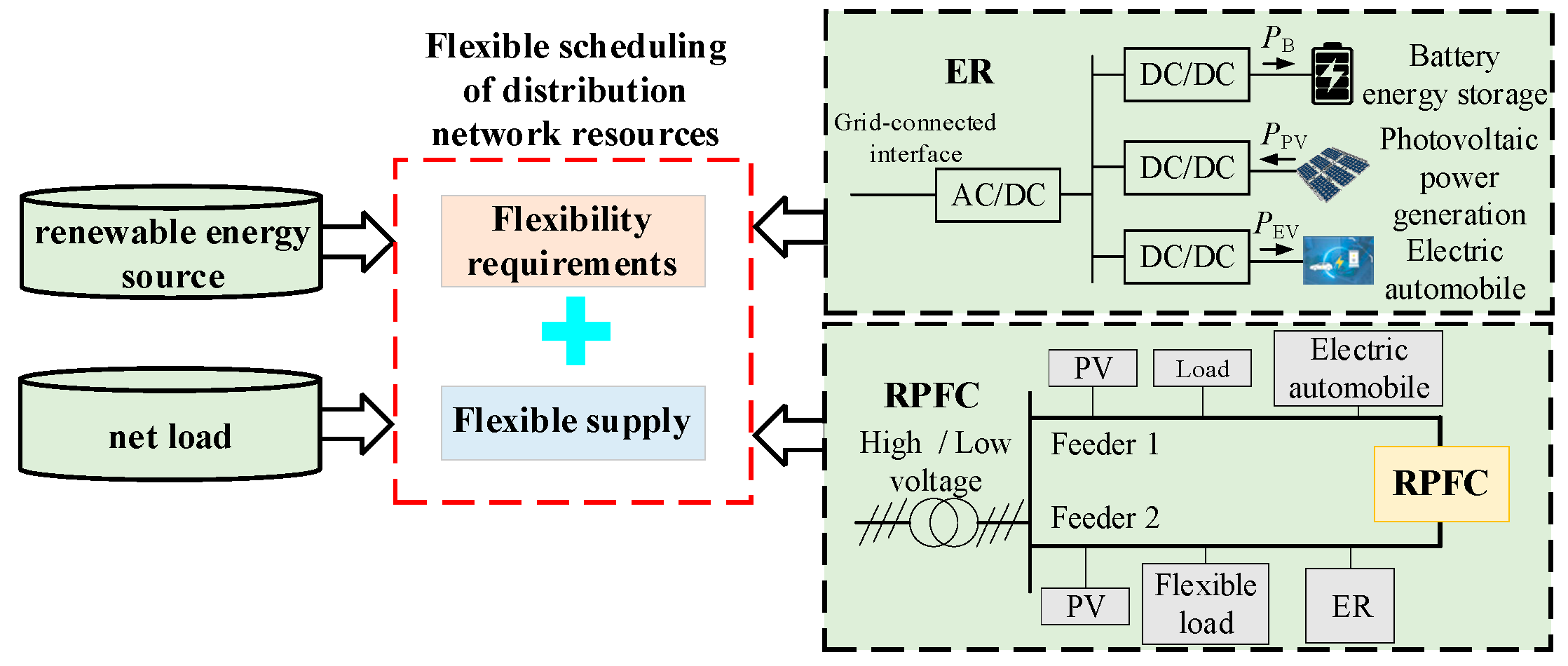

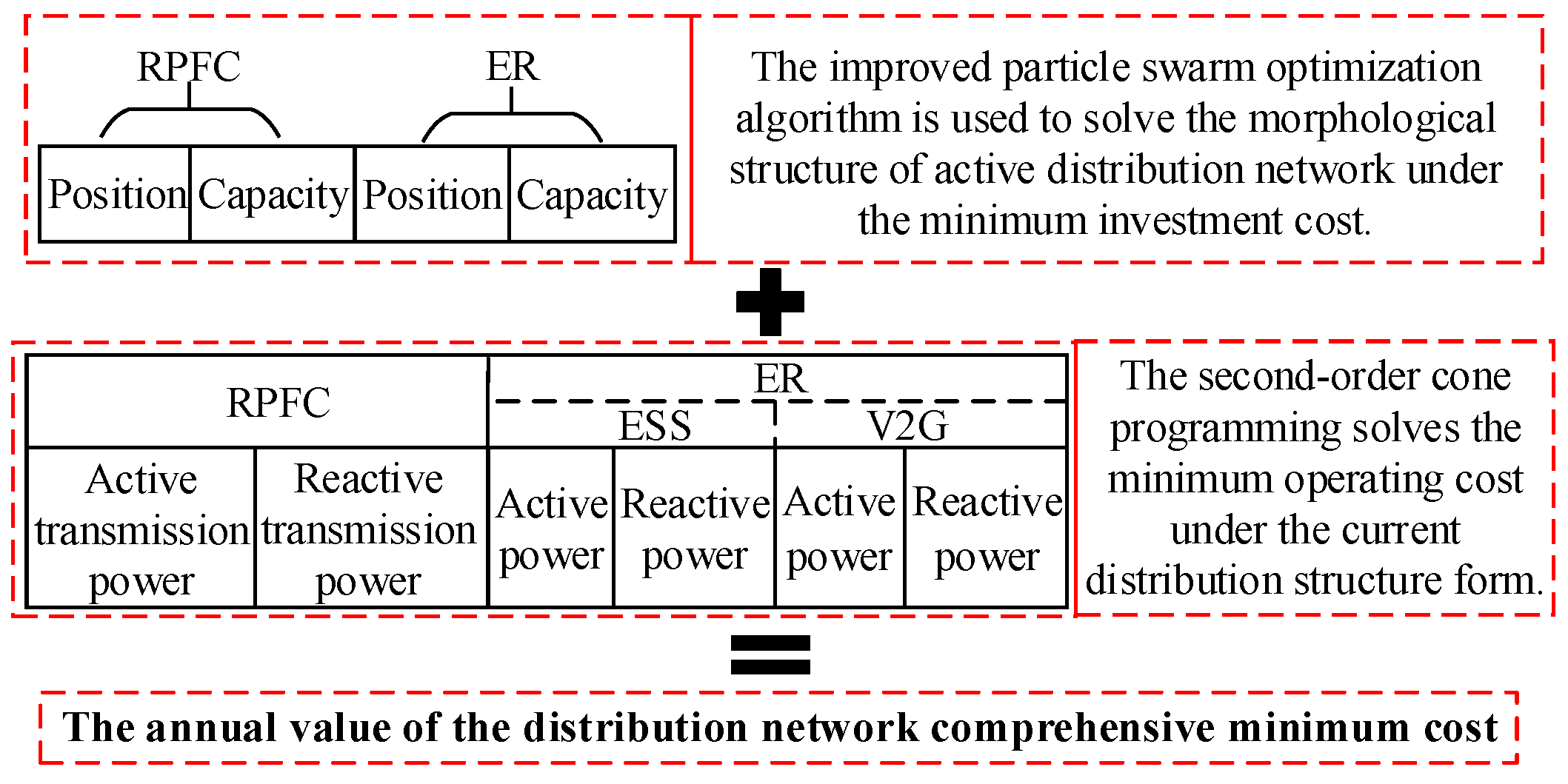



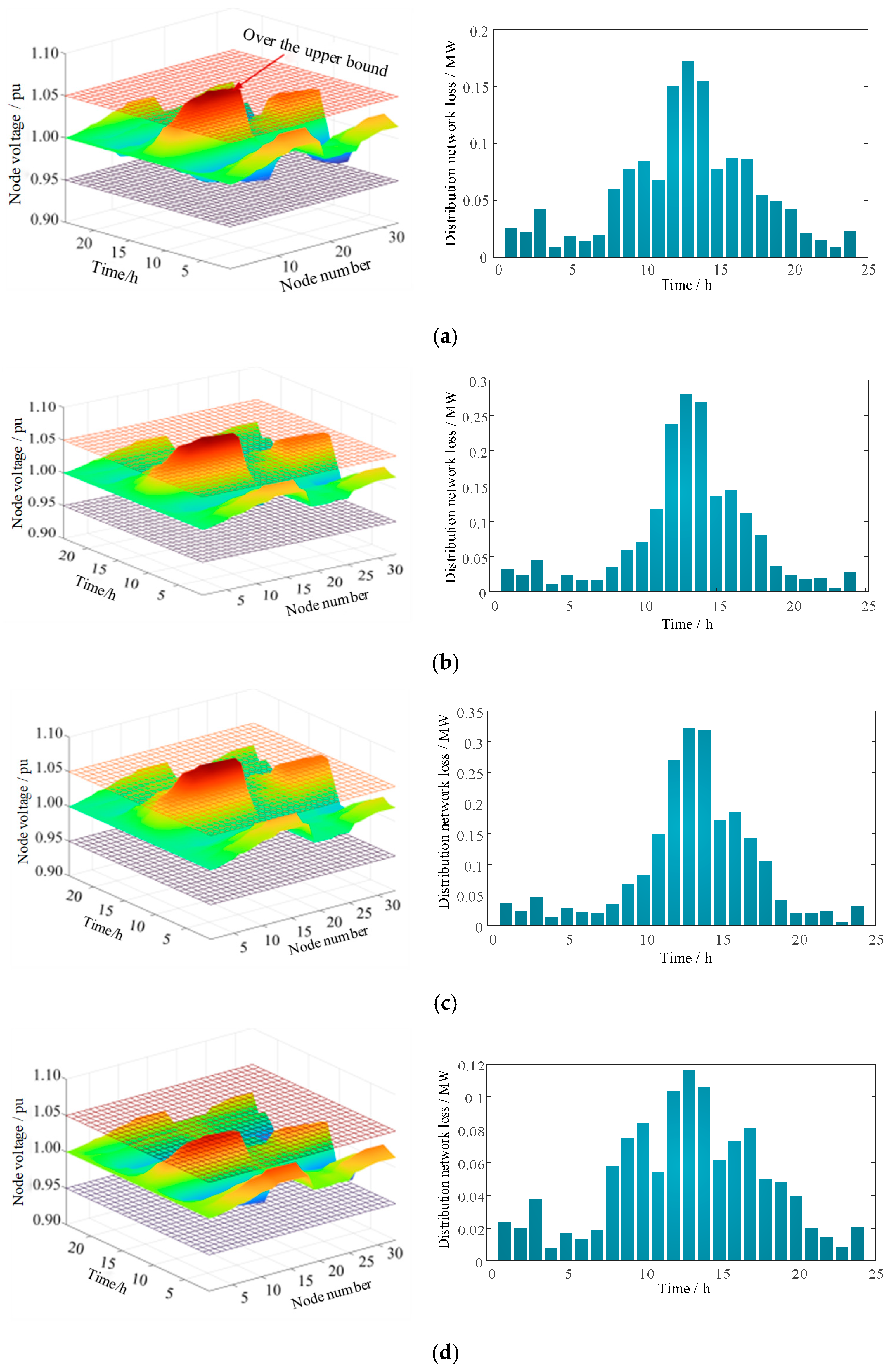

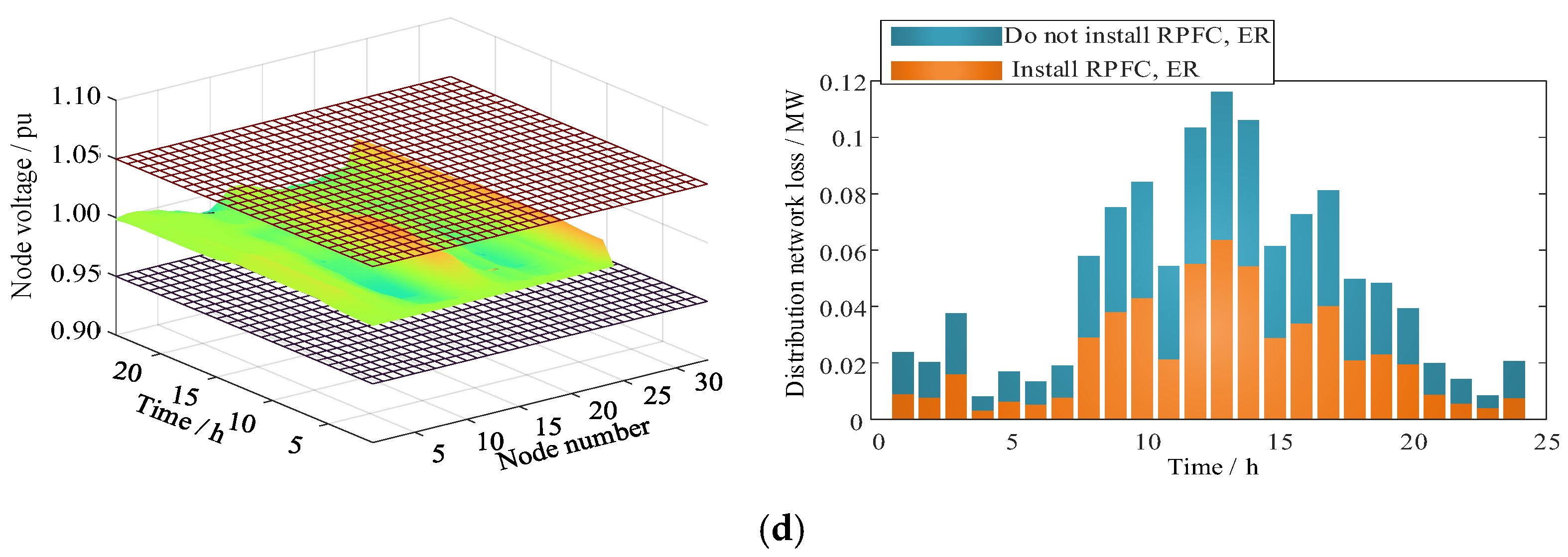
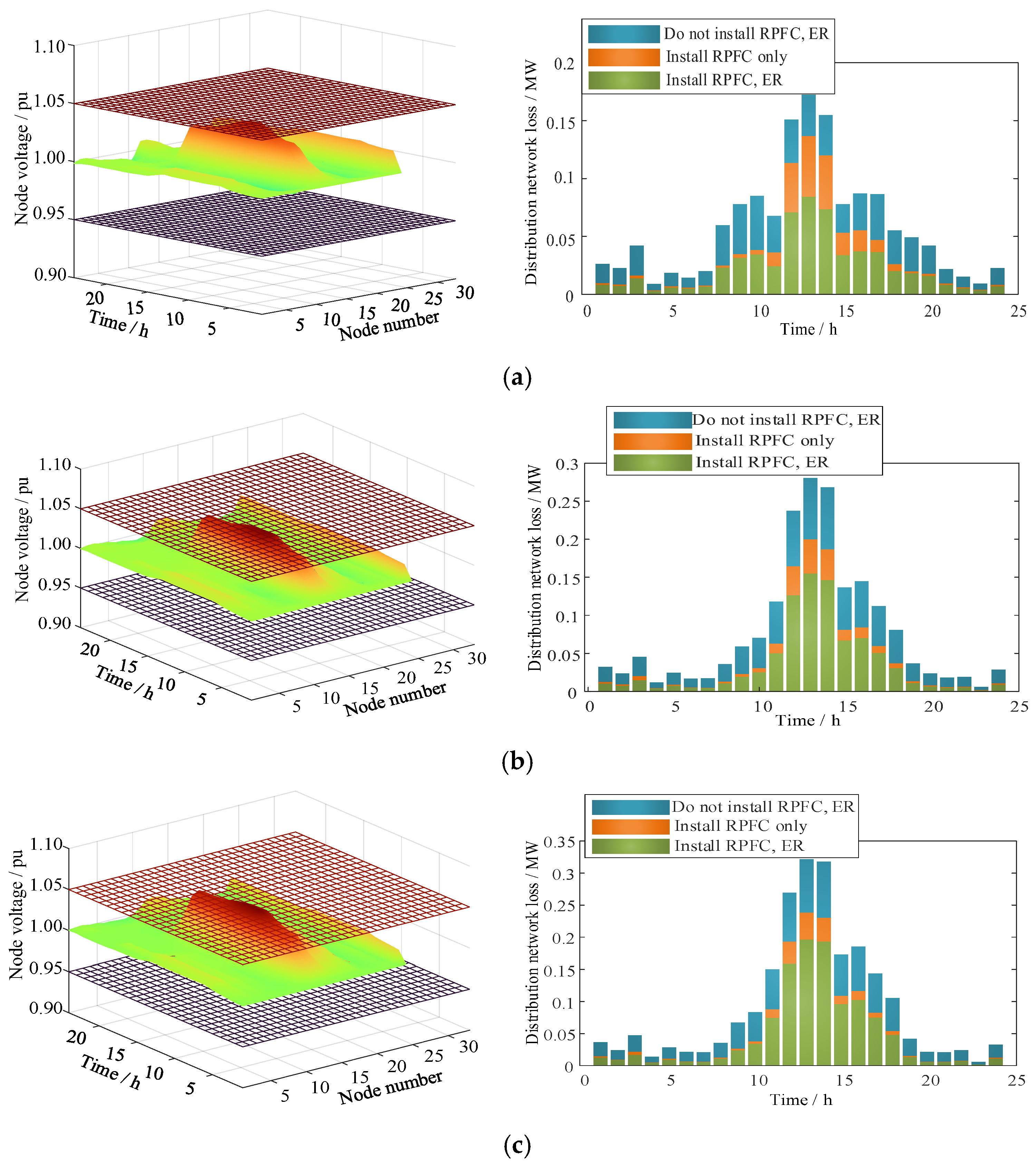
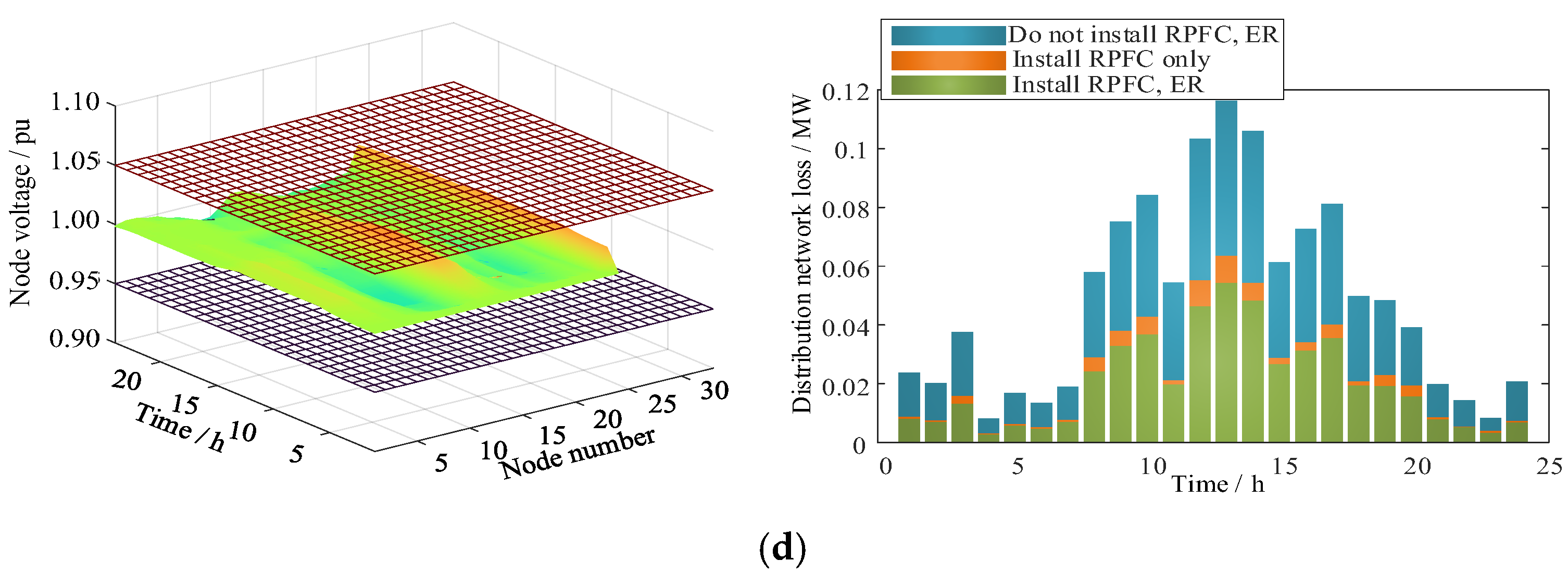

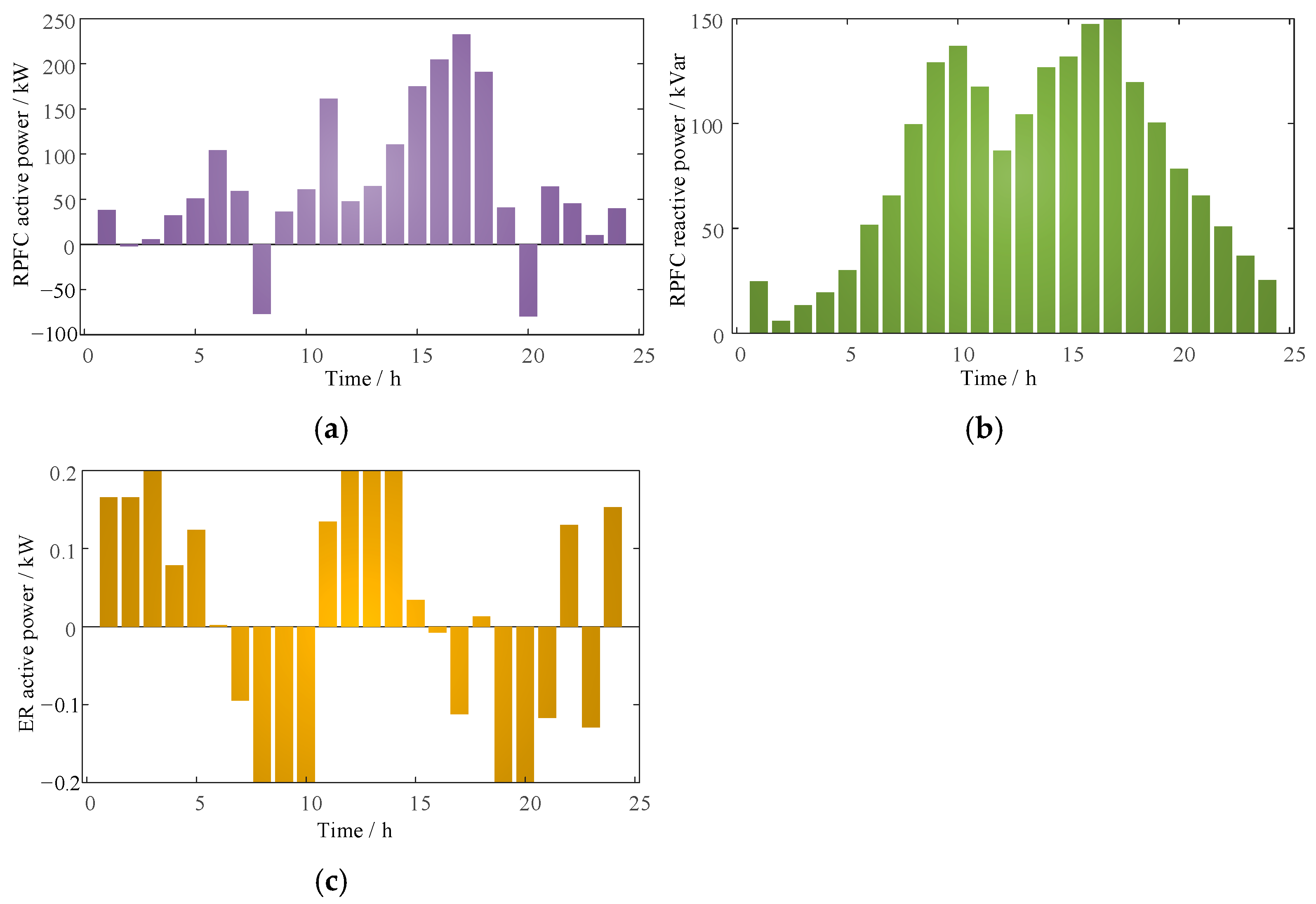
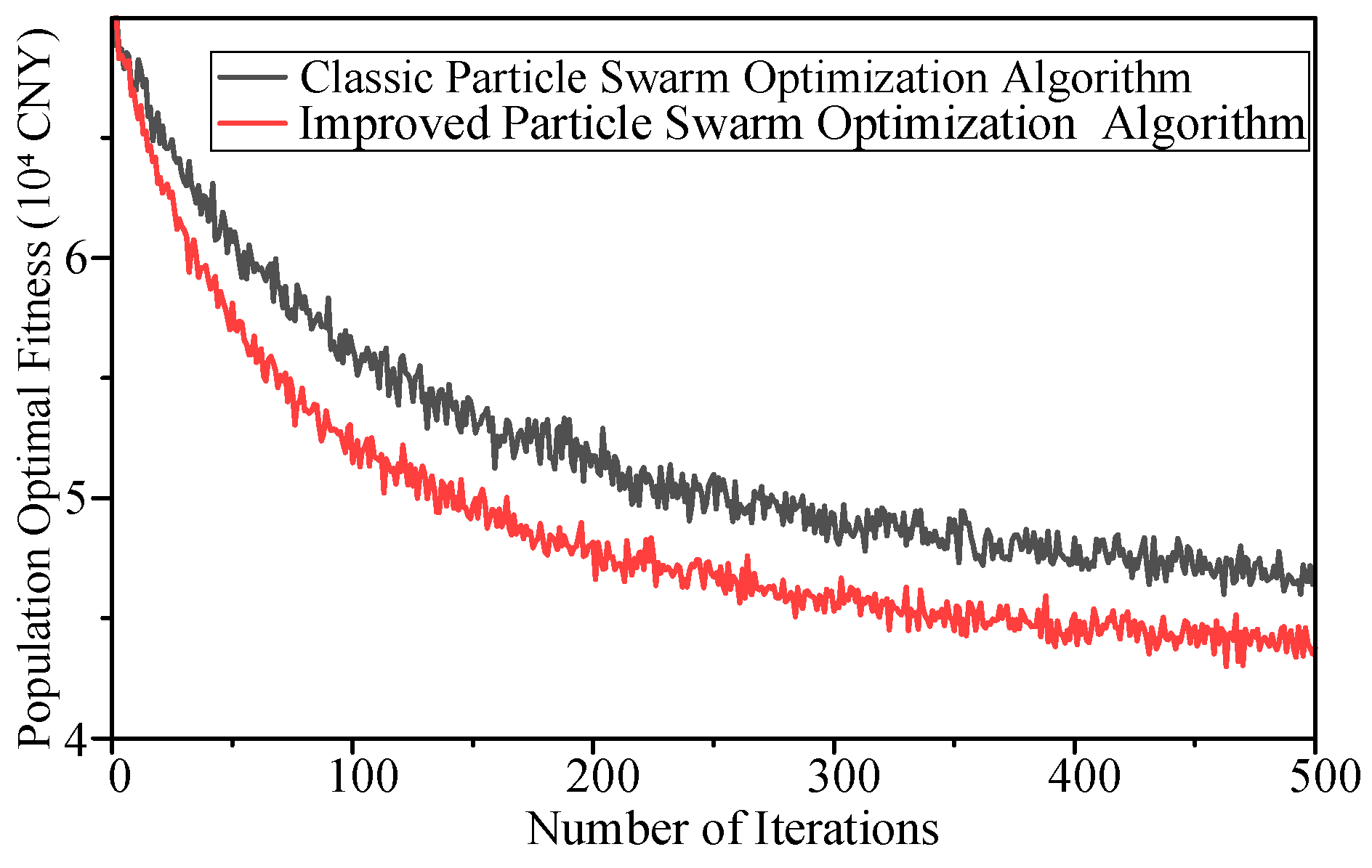

| Parameter Type | Numerical Value | Parameter Type | Numerical Value |
|---|---|---|---|
| FRPFC | 0–200 kVA: $110/kVA; 200–500 kVA: $85/kVA; 500–700 kVA: $55/kVA; 700–1000 kVA: $30/kVA; 1 MW and above: $20/KVA. | FERD | 0–50 kVA: $280/kVA; 50–100 kVA: $140/kVA; 100–200 kVA: $105/kVA; 200 kVA and above: $85/kVA. |
| FO-RPFC | k1 = 0.002 | FO-ER | k2 = 0.003; k3 = 0.001; k4 = 0.002; k5 = 0.001 |
| LT-ERD,DG,ES,V2G | 20 years | LT-RPFC | 30 years |
| d | 0.08 | 0.03 | |
| Fbuy-peak period | $0.08 | Fbuy-valley period | $0.04 |
| cPVG | $0.04/kW·h | FCE | $28,000 |
| Option 1 | Option 2 | Option 3 | ||
|---|---|---|---|---|
| Decision variables | RPFC | - | (9, 15), (0.8 WM) | (25, 29), (0.5 WM) |
| ER | - | - | (15), (0.3 WM) | |
| F1/$ | qRPFCFRPFC | - | 4290 | 3431 |
| qERFER | - | - | 2574 | |
| F2/$ | FO-RPFC | - | 7071 | 3247 |
| FO-ER | - | - | 2480 | |
| Fcur | 43,458 | - | - | |
| Floss | 41,248 | 23,426 | 19,203 | |
| Total cost/$ | 84,706 | 34,788 | 30,937 | |
Disclaimer/Publisher’s Note: The statements, opinions and data contained in all publications are solely those of the individual author(s) and contributor(s) and not of MDPI and/or the editor(s). MDPI and/or the editor(s) disclaim responsibility for any injury to people or property resulting from any ideas, methods, instructions or products referred to in the content. |
© 2024 by the authors. Licensee MDPI, Basel, Switzerland. This article is an open access article distributed under the terms and conditions of the Creative Commons Attribution (CC BY) license (https://creativecommons.org/licenses/by/4.0/).
Share and Cite
Jia, J.; Zhou, J.; Gao, Y.; Shao, C.; Lu, J.; Jia, J. A Rotating Tidal Current Controller and Energy Router Siting and Capacitation Method Considering Spatio-Temporal Distribution. Energies 2024, 17, 5919. https://doi.org/10.3390/en17235919
Jia J, Zhou J, Gao Y, Shao C, Lu J, Jia J. A Rotating Tidal Current Controller and Energy Router Siting and Capacitation Method Considering Spatio-Temporal Distribution. Energies. 2024; 17(23):5919. https://doi.org/10.3390/en17235919
Chicago/Turabian StyleJia, Junqing, Jia Zhou, Yuan Gao, Chen Shao, Junda Lu, and Jiaoxin Jia. 2024. "A Rotating Tidal Current Controller and Energy Router Siting and Capacitation Method Considering Spatio-Temporal Distribution" Energies 17, no. 23: 5919. https://doi.org/10.3390/en17235919
APA StyleJia, J., Zhou, J., Gao, Y., Shao, C., Lu, J., & Jia, J. (2024). A Rotating Tidal Current Controller and Energy Router Siting and Capacitation Method Considering Spatio-Temporal Distribution. Energies, 17(23), 5919. https://doi.org/10.3390/en17235919







